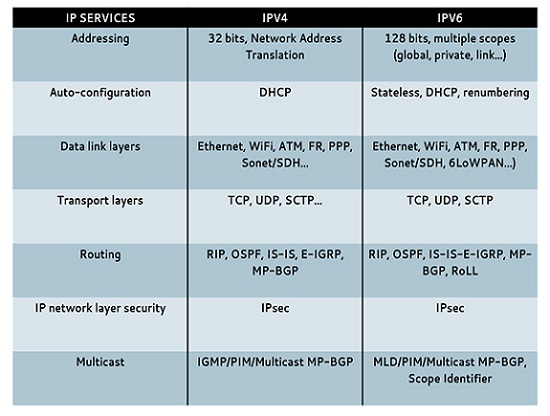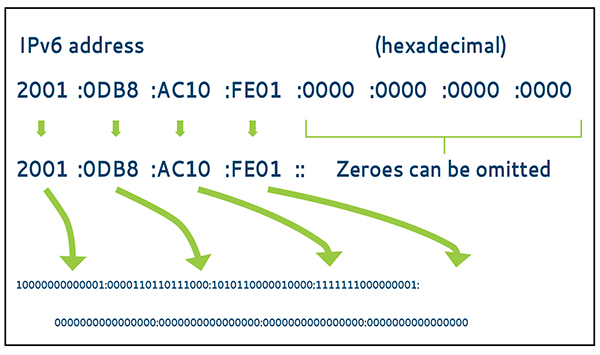The Tech Manager’s Guide to IPv6

“Don’t panic!” The classic line from The Hitchhiker’s Guide to the Galaxy could easily apply to the global shortage of IP addresses, otherwise known as IPv4. There’s panic in the streets, from wireless phone providers to IT managers alike, about what happens when we run out of IP addresses.
It’s the end of the world as we know it
Turns out, just like the Mayan calendar ended but 2013 began nonetheless, we’ve already passed the “point of no return” when it comes to IPv4 addresses. Some estimates say that the number of online devices passed the number of usable IP addresses in mid-2012. But the impact hasn’t yet been felt, because of the way that IP addresses are currently shared between devices.
Think of IP address sharing as two intersecting vectors. On the one hand, we have multiple devices that sit behind a router, which negotiates between a single wide-area network (WAN) IP address and multiple local-area network (LAN) addresses. The reason so many devices on a LAN have an IP address starting with 192.168.1.xxx is that the router they are attached to uses network address translation (NAT) to share a single WAN IP address. The trouble is, though, that each of these behind the- router devices are difficult to reach when it comes to connecting to a discrete device from the wider network (the WAN, aka the Internet).
On the other hand, we use routers and WAN sharing because not all IP-equipped devices can be on the Internet at the same time—not at least until we transition to IPv6—and the number of devices that need to be directly connected to the Internet is growing exponentially.
IPv4 addresses have a maximum simultaneous connection capacity just shy of 4.3 billion IP-equipped devices, yet technologists note that is not enough to have one IP address per person, let alone the ability to have multiple devices per person.
Up until now, we’ve been able to take a device offline, using that WAN address temporarily on another device, based on shorter and shorter TTL (time to live) settings. By late 2011, though, every connected Internet user had an average of 2.5 connected devices. In other words, it’s not enough to share addresses; instead, we need to either shorten the time a device is connected to the Internet or find a way to allow all devices to be connected all the time.
A daily selection of features, industry news, and analysis for tech managers. Sign up below.
The sharing via shortened TTLs can be explained best by the “free WiFi” phenomenon that we’ve all experienced at a McDonald’s or Starbucks location: the reason McDonald’s requires you to log in to its free WiFi setup again after five minutes of idle time is that McDonald’s is forced to share a few thousand IP addresses across hundreds of thousands of WiFi-equipped devices that pass through McDonalds’ locations in any given five-minute span of time. It’s a scarcity model writ large.
For critical services in the AV world, such as the device control systems from AMX, Crestron, and Extron, it’s not acceptable to suggest that a control device couldn’t be accessed from the WAN—or even from a virtual private network, or VPN—if other devices need to be connected to the outside world. There has to be a way to let all devices be connected when they need to be, without affecting the connectivity option of any other device.
IPv6 to the rescue
Some current sharing solutions take advantage of VPN-based IP sharing, but it’s just a patch job that delays the inevitable march towards every device being connected all the time.
Google alludes to the inevitability in a recent blog post commemorating the mid-2012 IPv6 Launch Day. The company noted that “the current Internet addressing system, IPv4 [is] not nearly enough for the world’s people, let alone the devices that are online today and those that will be in the future: computers, phones, TVs, watches, fridges, cars, and so on.”
The process to get to IPv6 addresses, which offer several hundred trillion IP addresses, will be a bit rocky, primarily due to the need to retrofit not just end-user devices but also servers, media appliances, and even legacy networking equipment.
Still the overall move towards IPv6 is beneficial to the AV industry as a whole, and those benefits don’t stop with IP-based device control systems. For instance, the ability to have a discrete IP address for projectors—from manufacturers as varied as BenQ, Epson, and Hitachi—means that corporate users and guests alike can be given pinpoint access to one single device in one conference room, without having wider access to the corporate network. In addition, new devices, such as streaming appliances offered by a number of AV product companies, also require access by both internal and external customers, requiring a discrete IP address to serve content to those who want to watch the live stream.
Understanding the math
Here’s a quick overview of how IP addressing schemes work, for a better understanding of why we’re in the current situation.
IPv4 is limited to just over four billion IP addresses primarily because it uses a base eight numbering system, known to most people as 8-bit addressing. Just like the eight-bit graphics of arcade games from two decades ago, like Donkey Kong, were replaced by higher-resolution 32- and 64-bit graphics from today’s Xbox or PlayStation, so too there’s a need to replace eight-bit addressing with something more.
IPv4 uses groupings of three numbers—considered an octet because each group uses a set of eight binary positions that can represent up to 256 possible combinations—and contains four groups which yields a total of 32 bits (four octets).

The entire globe of connected devices is at the mercy of those four octets of 256 possible combinations. To get beyond that limitation, the underlying math needs to be changed to allow for a much larger set of numbers.
IPv6 uses base 16 numbering, meaning that it uses the numbers 0-9 as well as the letters A-F. If you picked up on the fact that IPv6 uses hexadecimal numbering, give yourself two points. IPv6 also doubles the number of groups, offering a total of 128 bits to the total 32 bits available to IPv4 devices.
So what?
For the non-technical user or manager, even if you don’t understand hexadecimal numbering, just know that suddenly IPv6 will provide a whole lot more in terms of the possible devices connected to the Internet via a discrete IP address.
“How many more, exactly?” Google asks, rhetorically in its blog post. “Well, how about 340 trillion trillion trillion (or, 340,000,000,000,000 ,000,000,000,000,000,000,000,000)? That’s how many addresses the internet’s new “piping,” IPv6, can handle. That’s a number big enough to give everyone on Earth their own list of billions of IP addresses.”
There’s one more numbering trick you’ll need to know: the double colon (::) can represent a variable number of zeros. So in some IPv6 addresses, you might see a double colon, just like this example from a router I’ve been using in my office: eb80::6b7a:74ee:ec9d:72c8
The far right grouping (6b7a:74ee:ec9d:72c8) looks similar enough to a classic IPv4 address (e.g., 192.168.1.15) but includes the letters and one extra digit for further expansion. The far left four-digit hexadecimal group includes two colons between it and the rest of the numbering scheme, and those double colons account for at least one block of four missing zeros. We say “at least” because it’s possible for the double colon to represent more than one block of missing zeros.
What do I do now?
The bad news is that the vast majority of devices on the market don’t understand IPv6 addressing, but there’s a silver lining in all of this: you won’t need to ditch most of your equipment to make the initial transition to IPv6.
Knowing that there will be a long transition period, router and network switch manufacturers have upgraded devices to generate transitional IP addresses combine IPv4 and IPv6 together, using a modified NAT to allow legacy IPv4 devices to have a temporary IPv6 address. Legacy devices won’t have a direct IPv6 address, which affects the benefit of discrete access.
Reality check
For today’s AV manager, the reality of the IPv4-to- IPv6 transition will become a reality within the next eighteen months. Depending on the attention your IT department has paid to the situation, it may be a relatively seamless transition from NAT addresses (e.g., 192.168.1.15) to transitional IPv4- IPv6 addresses (which often start with “2002”).
Once the transition is underway, AV managers should strongly consider the IPv6 capability of each new device they purchase, as the benefit to controlling and managing pure IPv6 devices can lead to a more secure network without giving up the ability to offer authenticated external customers and vendors access to a discrete device on a case-by-case basis.
Tim Siglin is chairman of Braintrust Digital, a media production and systems design firm. He has been involved in AV technologies, including digital signage networks, streaming media, and videoconferencing for almost two decades. He can be reached at writer@braintrustdigital.com.
